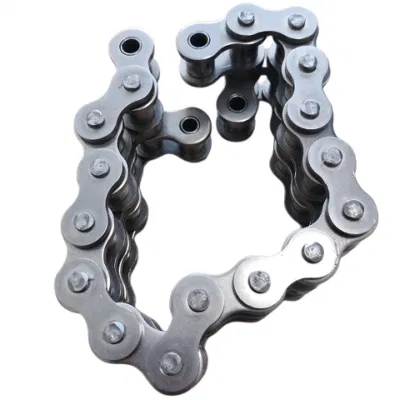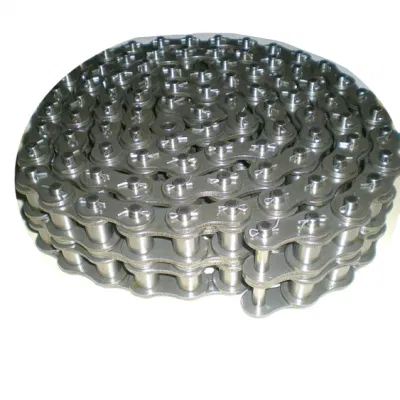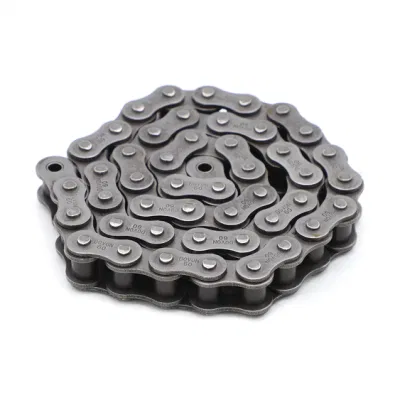Product Description
About Factory
With more than 18 years’ histiory, we are a professinal manufacturer for drop forged products such as forged chain (X348 X458 X658 X678 X698 F100 F160), scraper chain (10160, 14218, 14226, 142N), conveyor trolley (X348, X458, X678, XT160), and drive chain (X348, X458, X678), and so forth standard moulds of chain.
Besides, we can also produce as per your drawing or sample, special link chain, pusher, pin and plate, according to customers’ unique requirements.
Product Description
1) Material: Alloy steel, 40Cr, 42CrMo and so on.
2) Types: Standard types, X348 X458 X678, and so on. (Or as per your drawing)
3) Process: Moulding→Forging→Polishing & Blasting→Fine machining→Heat treatment→Blasting→Inspecting & testing→Packing
Product Show
Technical Data
| Model | Dimension | Weight (Kg) | Material | Hardness | Working Load (KN) | Limit Load (KN) | ||||||
| P | T | C | S | F | R | D | ||||||
| 10160B | 101.6 | 24 | 36 | 13 | 14 | 6 | 14 | 0.32 | 20CrMnTi | Surface HRC56-64° Depth 0.6-1.2mm |
18 | 100 |
| 10160 | 101.6 | 30 | 36 | 13 | 14.5 | 9 | 14 | 0.36 | 20CrMnTi | Surface HRC56-64° Depth 0.6-1.2mm | 21.6 | 120 |
| 14218 | 142 | 42 | 50 | 19 | 20.5 | 11 | 25 | 1.15 | 20CrMnTi | Surface HRC56-64° Depth 0.6-1.2mm | 48.6 | 270 |
| 14226 | 142 | 62 | 50 | 28 | 30 | 15 | 25 | 1.75 | 20CrMnTi | Surface HRC56-64° Depth 0.6-1.2mm | 61.2 | 340 |
| 2571 | 200 | 66 | 60 | 30 | 32 | 18 | 30 | 2.8 | 20CrMnTi | Surface HRC56-64° Depth 0.6-1.2mm | 72 | 400 |
| 26014 | 260 | 70 | 75 | 31 | 33 | 20 | 34 | 5.2 | 20CrMnTi | Surface HRC56-64° Depth 0.6-1.2mm | 135 | 750 |
| 142N | 142 | 43 | 50 | 19 | 22 | 12.5 | 25 | 1.2 | 40Cr | Quench HRC36-44° | 75.6 | 420 |
| 150D | 142 | 42 | 50 | 19 | 20.5 | 11 | 25 | 1.15 | 40Cr | Quench HRC36-44° | 75.6 | 420 |
| MG20 | 200 | 70 | 50 | 27 | 29 | 17 | 35 | 3.78 | 40Cr | Quench HRC36-44° | 144 | 800 |
| MG20B | 200 | 70 | 50 | 27 | 29 | 17 | 30 | 3.82 | 40Cr | Quench HRC36-44° | 140.4 | 780 |
| MG20C | 200 | 70 | 50 | 27 | 29 | 17 | 28 | 3.85 | 40Cr | Quench HRC36-44° | 122.4 | 680 |
| MS32 | 200 | 42 | 50 | 20 | 22 | 12 | 25 | 1.4 | 40Cr | Quench HRC36-44° | 75.6 | 420 |
| MS55 | 200 | 80 | 70 | 35 | 38 | 25 | 28 | 4.36 | 40Cr | Quench HRC36-44° | 138.6 | 770 |
| 3006 | 200 | 65 | 70 | 30 | 33 | 24 | 32 | 3.6 | 40Cr | Quench HRC36-44° | 160.2 | 890 |
| MS63 | 250 | 70 | 80 | 30 | 33 | 20 | 32 | 4.93 | 40Cr | Quench HRC36-44° | 147.6 | 820 |
| S16 | 100 | 30 | 27 | 15 | 16 | 8 | 14 | 0.3 | 40Cr | Quench HRC36-44° | 16 | 88 |
| S20 | 125 | 34 | 33 | 17 | 18 | 8 | 17 | 0.37 | 40Cr | Quench HRC36-44° | 19.4 | 108 |
| S25 | 160 | 48 | 39 | 23 | 25 | 13 | 20 | 1.28 | 40Cr | Quench HRC36-44° | 55.8 | 310 |
| S30 | 142 | 46 | 49 | 22 | 23.5 | 14 | 25 | 1.3 | 40Cr | Quench HRC36-44° | 91.8 | 510 |
| Z16 | 100 | 40 | 35 | 18 | 20 | 12 | 17 | 0.4 | 40Cr | Quench HRC36-44° | 32.4 | 180 |
| Z20 | 125 | 50 | 46 | 24 | 26 | 15 | 20 | 0.67 | 40Cr | Quench HRC36-44° | 59.4 | 330 |
| Z20D | 125 | 52 | 60 | 24 | 26 | 16 | 26 | 1.15 | 40Cr | Quench HRC36-44° | 82.8 | 460 |
| Z25 | 160 | 58 | 55 | 28 | 30 | 18 | 25 | 2.25 | 40Cr | Quench HRC36-44° | 82.8 | 460 |
| Z25D | 160 | 66 | 64 | 29 | 31 | 22 | 28 | 2.6 | 40Cr | Quench HRC36-44° | 120.6 | 670 |
| Z30 | 142 | 64 | 50 | 29 | 30.5 | 18 | 25 | 1.8 | 40Cr | Quench HRC36-44° | 111.6 | 620 |
Products & Testing Equipments
Products Application
Packing & Delivery
Why Choose Us?
1. We are engaged in chain industry over 15 years with rich market experience. We keep improving production techniques. All the products have longer working life and have passed the market test.
2. We can design the correct chains with high quality material, good abrasion resistance, good corrosion, high strengthen and etc as per your request or the chain application.
3. We are the chain manufacturer; you can directly purchase the product from us with low price and high quality.
4. We have a professional team for international trade, they have abundant experiences and are always ready to solve problems for customers. So you have nothing to worry about.
5. We have the long-term cooperative forwarder who can give us the lowest freight. And it can help you to save the freight. What’s more, for the FCL, we will design the packages as per the container sizes with the largest capacity to save the shipping cost for both of us.
/* January 22, 2571 19:08:37 */!function(){function s(e,r){var a,o={};try{e&&e.split(“,”).forEach(function(e,t){e&&(a=e.match(/(.*?):(.*)$/))&&1
| Standard or Nonstandard: | Standard |
|---|---|
| Application: | Textile Machinery, Garment Machinery, Conveyer Equipment, Packaging Machinery, Electric Cars, Motorcycle, Food Machinery, Mining Equipment, Agricultural Machinery, Coating, Spraying, Mining, Slaughtering, Assembly |
| Surface Treatment: | Polishing |
| Structure: | Combined Chain |
| Material: | Alloy |
| Type: | Cranked Link Chain |
| Samples: |
US$ 5/Piece
1 Piece(Min.Order) | |
|---|
| Customization: |
Available
| Customized Request |
|---|

Can a bush chain be used in high-temperature applications?
Yes, bush chains can be designed and manufactured to withstand high-temperature environments. However, the specific temperature range in which a bush chain can operate depends on several factors, including the materials used, lubrication, and the design of the chain.
When considering the use of a bush chain in high-temperature applications, it is important to consider the following:
1. Material selection: Choose materials that can withstand the elevated temperatures without significant degradation. Heat-resistant alloys or specially treated materials with high-temperature resistance are commonly used in bush chain construction.
2. Lubrication: Proper lubrication is critical in high-temperature applications to reduce friction and prevent premature wear. Select lubricants specifically formulated for high-temperature environments. These lubricants should have a higher viscosity index and thermal stability to maintain their effectiveness at elevated temperatures.
3. Design considerations: The design of the bush chain should account for the thermal expansion and contraction that occurs at high temperatures. Adequate clearance should be provided to accommodate the thermal expansion of the chain components.
4. Heat dissipation: Ensure proper heat dissipation from the chain by allowing sufficient airflow or implementing cooling mechanisms in the system. This helps to prevent excessive heat buildup and potential damage to the chain.
5. Temperature limits: Consult the manufacturer’s specifications and guidelines to determine the maximum temperature limit for the bush chain. Operating the chain within its temperature limits ensures its reliability and longevity.
It is important to note that the performance and lifespan of a bush chain can be affected by prolonged exposure to high temperatures. Continuous monitoring and regular inspections are recommended to ensure the chain’s integrity and identify any signs of wear or damage that may be accelerated by the high-temperature environment.

What are the design considerations for a bush chain system?
When designing a bush chain system, several key considerations should be taken into account to ensure its reliable and efficient operation. These design considerations include:
1. Load capacity: Evaluate the expected loads that the bush chain system will need to handle. Consider the weight, size, and type of materials or products being conveyed or transmitted. Select a bush chain with a suitable load capacity to ensure it can withstand the required loads.
2. Speed and acceleration: Determine the desired operating speed and acceleration of the bush chain system. This will influence the selection of chain pitch, material, and lubrication requirements. Higher speeds may require additional considerations such as reduced friction or increased precision.
3. Environmental conditions: Evaluate the operating environment for the bush chain system. Consider factors such as temperature, humidity, dust, chemicals, and presence of corrosive or abrasive substances. Select a bush chain material and coating that can withstand the environmental conditions and resist corrosion or wear.
4. Space limitations: Assess the available space for the installation of the bush chain system. Consider the dimensions and layout of the equipment, conveyor, or transmission system. Ensure that there is sufficient clearance for the chain’s movement and that the system can be properly tensioned and aligned.
5. Alignment and tensioning: Proper tensioning and alignment are critical for the smooth operation of a bush chain system. Design the system to include tensioners, idler sprockets, or adjustable mounting options to facilitate easy tensioning and alignment adjustments.
6. Lubrication and maintenance: Determine the lubrication requirements of the bush chain system. Consider the frequency and method of lubrication, as well as any accessibility constraints for maintenance. Select a lubrication method that suits the application, such as manual lubrication, automatic lubrication systems, or self-lubricating bush chains.
7. Safety considerations: Ensure that the bush chain system is designed with appropriate safety measures. Incorporate guards, covers, or enclosures where necessary to prevent accidental contact with moving parts. Consider emergency stop systems and safety interlocks for the protection of personnel and equipment.
By carefully considering these design factors, a bush chain system can be optimized for performance, reliability, and longevity in a specific application or industry.

What are the main components of a bush chain?
A bush chain consists of several key components that work together to enable efficient power transmission. The main components of a bush chain include:
1. Bushings: Bushings are cylindrical components with a hollow bore that fit into the chain links. They provide a low-friction interface between the chain pins and the link plates, allowing smooth rotation and reducing wear.
2. Pins: Pins are cylindrical metal rods that connect the inner plates and outer plates of the chain links. They pass through the bushings and provide the rotational movement of the chain. The pins are hardened and precisely machined to withstand the loads and provide durability.
3. Link Plates: Link plates are flat metal plates that are connected by the pins. They form the main structure of the chain and transmit the tensile forces. The link plates are typically made of high-strength steel and are designed to withstand the applied loads.
4. Rollers: Some bush chains feature rollers that are located between the link plates and the bushings. These rollers allow smoother engagement with sprockets or other mating components, reducing friction and enhancing the chain’s performance. Rollers also help to maintain proper chain tension.
5. Retaining Clips or Rivets: Retaining clips or rivets are used to secure the pins in place and prevent them from rotating within the link plates. They ensure the integrity of the chain assembly and maintain the proper alignment of the components.
6. Lubrication: Lubrication is crucial for the proper functioning and longevity of a bush chain. It helps to reduce friction, minimize wear, and prevent corrosion. Lubrication can be applied through various methods, such as oil bath, oil drip, or periodic lubrication.
These components work together to provide reliable power transmission in bush chain systems. The precise design and construction of each component contribute to the overall strength, durability, and efficiency of the chain.


editor by CX 2024-04-16
